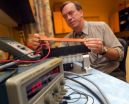(Press-News.org) AUGUSTA, Ga. - A daily dose of whole body vibration may help reduce the usual bone density loss that occurs with age, Medical College of Georgia researchers report.
Twelve weeks of daily, 30-minute sessions in 18-month old male mice – which equate to 55- to 65-year-old humans – appear to forestall the expected annual loss that can result in fractures, disability and death. Dr. Karl H. Wenger, biomedical engineer in the MCG Schools of Graduate Studies and Medicine, reported the findings with his colleagues in the journal Bone.
Researchers found vibration improved density around the hip joint with a shift toward higher density in the femur, the long bone of the leg, as well. Hip fractures are a major cause of disability and death among the elderly.
They also found a reduction in a biomarker that indicates bone breakdown and an increase in the surface area involved in bone formation in the vibrating group.
The findings provide more scientific evidence that the technique, which dates back to the 1800s and is now showing up in homes, gyms and rehabilitation clinics, has bone benefit, particularly as a low-risk option for injured individuals with limited mobility, Wenger said.
The scientists theorize that the rhythmic movement, which produces a sensation similar to that of a vibrating cell phone but on a larger scale, exercises cells so they work better. Vibration prompts movement of the cell nucleus, which is suspended by numerous threadlike fibers called filaments. "The filaments get all deformed like springs and then they spring back," Wenger said.
All the movement releases transcription factors that spur new osteoblasts, the cells that make bone. With age, the balance of bone production and destruction – by osteoclasts – tips to the loss side.
In the case of an injury, vibration acts on stem cells, the master controllers of the healing process. "We think that in fracture healing, you get a more dramatic response. We don't know exactly why it affects the biology differently but it's likely because of the extent to which stem cells invade the injured area," Wenger said. They have found that vibration slows stem cell proliferation, which may sound counterintuitive, but likely means more stem cells differentiate into bone cells rather than continuing to just make more generic stem cells. With age, stem cells have difficulty differentiating.
To see if their findings translate to the trauma clinic, they are evaluating vibration tolerance in patients with lower-limb fractures and finding, surprisingly, that even two weeks after injury the subtle vibration is soothing, rather than painful, to most.
The bone group, based in the MCG Department of Orthopaedic Surgery, also is working with Georgia Prevention Institute scientists to explore vibration's potential to improve glucose uptake – to see if vibration results in more insulin production or aids glucose clearance in some other way – and whether, like exercise, it can reduce fatty liver disease in chunky, pre-diabetic children.
In related studies, postmenopausal women at the peak age of bone decline, experienced results similar to those of Wenger's aging mice. Wenger's studies used only male mice to mitigate the impact of fluctuating hormones and focus on aging. In the human study, led by Dr. Clinton T. Rubin at the State University of New York at Stony Brook, the women receiving daily whole body vibration didn't gain appreciable bone but they did not lose it either.
While vibration lacks the same cardiovascular benefit of exercise, animal and human studies also have shown it can improve muscle strength and weight loss.
INFORMATION:
Daily vibration may help aging bones stay healthy
2010-10-26
ELSE PRESS RELEASES FROM THIS DATE:
Plant stem cells could be fruitful source of low-cost cancer drug
2010-10-26
A popular cancer drug could be produced cheaply and sustainably using stem cells derived from trees, a study suggests.
Researchers have isolated and grown stem cells from a yew tree whose bark is a natural source of the anticancer compound paclitaxel. The development could enable the compound to be produced on a commercial scale at low cost, with no harmful by-products.
Scientists and engineers behind the development say the drug treatment – currently used on lung, ovarian, breast, head and neck cancer – could become cheaper and more widely available.
The study was ...
Radiation before surgery keeps colorectal cancer from returning
2010-10-26
Patients with cancer found at the end of the large intestine called the rectum who receive one week of radiation therapy before surgery have a 50 percent reduction in chance that their cancer will return after 10 years, according to a large, randomized study presented at the plenary session, November 1, 2010, at the 52nd Annual Meeting of the American Society for Radiation Oncology (ASTRO).
"We believe that this short course of radiation will open a new window of opportunities in the treatment of rectal cancer," Corrie Marijnen M.D., lead author of the study and a radiation ...
Aspirin use associated with lower risk of cancer death for men with prostate cancer
2010-10-26
Men with prostate cancer who take anticoagulants like aspirin in addition to radiation therapy or surgery may be able to cut their risk of dying of the disease by more than half, according to a large study presented on November 3, 2010, at the 52nd Annual Meeting of the American Society for Radiation Oncology (ASTRO) in San Diego. The study involved more than 5,000 men with localized cancer whose disease had not spread beyond the prostate gland.
"Evidence has shown that anticoagulants may interfere with cancer growth and spread," Kevin Choe, M.D., Ph.D., lead author of ...
Prostate cancer screening improves quality of life by catching disease before it spreads
2010-10-26
Men treated for prostate cancer who were diagnosed after the start of routine screening had a significantly reduced risk of the disease spreading to other parts of the body (metastases) within 10 years of treatment, compared to men who were treated prior to the use of routine screening, according to the first study-of-its-kind presented November 1, 2010, at the 52nd Annual Meeting of the American Society for Radiation Oncology (ASTRO).
In 1993, routine prostate cancer screening became widely implemented through the use of a prostate specific antigen (PSA) test that was ...
Adding radiation to hormone therapy for prostate cancer treatment will increase survival chances
2010-10-26
Prostate cancer patients who are treated with a combination of hormone therapy and radiation have a substantially improved chance of survival compared to patients who do not receive radiation, according to interim results of the largest randomized study of its kind presented at the plenary session, November 1, 2010, at the 52nd Annual Meeting of the American Society for Radiation Oncology (ASTRO).
From 1995 to 2005, 1,205 men with high-risk prostate cancer in the United States, the United Kingdom and Canada were randomly selected to receive hormone therapy alone or a ...
New American Chemical Society Prized Science video focuses on 'green gasoline'
2010-10-26
WASHINGTON, Oct. 25, 2010 — Green gasoline is plants in your tank, motor vehicle fuel made from corn, cornstalks, sugarcane, and other crops. It also is gasoline made with recipes that reduce the need for harsh, potentially toxic ingredients like hydrofluoric acid or sulfuric acid that are used at about 210 oil refineries worldwide. Now scientists have found an answer to a half-century quest for a way to make gasoline in exactly that kind of greener, more environmentally-friendly way.
That advance highlights the second episode of a new video series, Prized Science: ...
Highly targeted radiation technique minimizes side effects of prostate cancer treatment
2010-10-26
Men with prostate cancer treated with a specialized type of radiation called intensity modulated radiation therapy (IMRT) have fewer gastrointestinal complications compared to patients treated with conventional three-dimensional conformal radiotherapy (3D-CRT), according to a study presented November 1, 2010, at the 52nd Annual Meeting of the American Society for Radiation Oncology (ASTRO).
"With survivors living many years after treatment, it is very important to minimize gastrointestinal and urinary side effects to allow patients to live a full life after treatment," ...
Newer, more intense chemotherapy with less radiation not more effective against Hodgkin's lymphoma
2010-10-26
A lower dose of radiation used to reduce side effects is not as effective as the regular dose when given with the standard chemotherapy in the treatment of Hodgkin's lymphoma patients with early, intermediate-stage disease, according to a first-of-its-kind randomized study presented at the plenary session, November 1, 2010, at the 52nd Annual Meeting of the American Society for Radiation Oncology (ASTRO).
In addition, the trial showed that a more intensive chemotherapy (BEACOPP) is not more effective than the standard chemotherapy treatment (ABVD) for these patients.
"This ...
What can country of birth tell us about childhood asthma?
2010-10-26
BOSTON (October 25, 2010) — Researchers from Tufts University pooled data from five previous epidemiological studies to investigate the prevalence of asthma in children in the Boston neighborhoods of Chinatown and Dorchester. Among children born in the United States, low socioeconomic status (SES) and exposure to pests (mice and cockroaches) were both associated with having asthma. Neither association was present in children born outside of the United States. The study was published online in advance of print in the Journal of Immigrant and Minority Health.
"In earlier ...
Chemotherapy plus radiation prevents bladder cancer recurrences
2010-10-26
Adding chemotherapy to radiation therapy for muscle invasive bladder cancer allows 67 percent of people to be free of disease in their bladders two years after treatment. This compares to 54 percent of people who receive radiation alone, according to the largest randomized study of its kind presented at the plenary session, November 1, 2010, at the 52nd Annual Meeting of the American Society for Radiation Oncology (ASTRO).
"The trial shows that this treatment offers improved control of cancer within the bladder with acceptable long-term side effects and is therefore a ...

